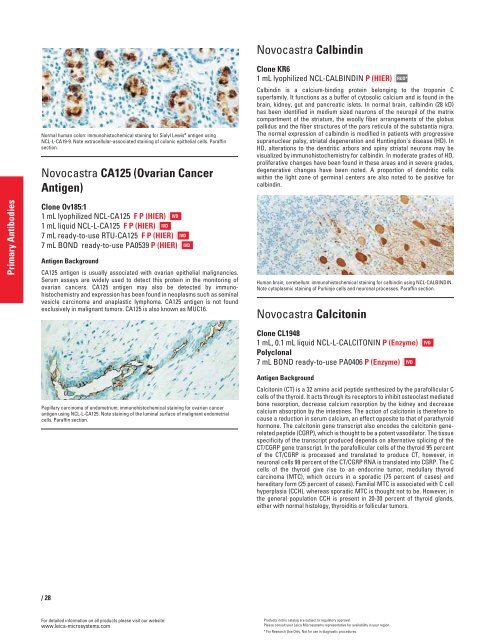QF0159 Marketing Release Record
QF0159 Marketing Release Record
QF0159 Marketing Release Record
You also want an ePaper? Increase the reach of your titles
YUMPU automatically turns print PDFs into web optimized ePapers that Google loves.
Primary Antibodies<br />
Normal human colon: immunohistochemical staining for Sialyl Lewis a antigen using<br />
NCL-L-CA19-9. Note extracellular-associated staining of colonic epithelial cells. Paraffin<br />
section.<br />
Novocastra CA125 (Ovarian Cancer<br />
Antigen)<br />
Clone Ov185:1<br />
1 mL lyophilized NCL-CA125 F P (HIER)<br />
1 mL liquid NCL-L-CA125 F P (HIER)<br />
7 mL ready-to-use RTU-CA125 F P (HIER)<br />
7 mL BOND ready-to-use PA0539 P (HIER)<br />
Antigen Background<br />
CA125 antigen is usually associated with ovarian epithelial malignancies.<br />
Serum assays are widely used to detect this protein in the monitoring of<br />
ovarian cancers. CA125 antigen may also be detected by immunohistochemistry<br />
and expression has been found in neoplasms such as seminal<br />
vesicle carcinoma and anaplastic lymphoma. CA125 antigen is not found<br />
exclusively in malignant tumors. CA125 is also known as MUC16.<br />
Papillary carcinoma of endometrium: immunohistochemical staining for ovarian cancer<br />
antigen using NCL-L-CA125. Note staining of the luminal surface of malignant endometrial<br />
cells. Paraffin section.<br />
/28<br />
For detailed information on all products please visit our website:<br />
www.leica-microsystems.com<br />
IVD<br />
IVD<br />
IVD<br />
IVD<br />
Novocastra Calbindin<br />
Clone KR6<br />
1 mL lyophilized NCL-CALBINDIN P (HIER)<br />
Calbindin is a calcium-binding protein belonging to the troponin C<br />
superfamily. It functions as a buffer of cytosolic calcium and is found in the<br />
brain, kidney, gut and pancreatic islets. In normal brain, calbindin (28 kD)<br />
has been identified in medium sized neurons of the neuropil of the matrix<br />
compartment of the striatum, the woolly fiber arrangements of the globus<br />
pallidus and the fiber structures of the pars reticula of the substantia nigra.<br />
The normal expression of calbindin is modified in patients with progressive<br />
supranuclear palsy, striatal degeneration and Huntingdon's disease (HD). In<br />
HD, alterations to the dendritic arbors and spiny striatal neurons may be<br />
visualized by immunohistochemistry for calbindin. In moderate grades of HD,<br />
proliferative changes have been found in these areas and in severe grades,<br />
degenerative changes have been noted. A proportion of dendritic cells<br />
within the light zone of germinal centers are also noted to be positive for<br />
calbindin.<br />
Human brain, cerebellum: immunohistochemical staining for calbindin using NCL-CALBINDIN.<br />
Note cytoplasmic staining of Purkinje cells and neuronal processes. Paraffin section.<br />
Novocastra Calcitonin<br />
Clone CL1948<br />
1 mL, 0.1 mL liquid NCL-L-CALCITONIN P (Enzyme)<br />
Polyclonal<br />
7 mL BOND ready-to-use PA0406 P (Enzyme) IVD<br />
Antigen Background<br />
Calcitonin (CT) is a 32 amino acid peptide synthesized by the parafollicular C<br />
cells of the thyroid. It acts through its receptors to inhibit osteoclast mediated<br />
bone resorption, decrease calcium resorption by the kidney and decrease<br />
calcium absorption by the intestines. The action of calcitonin is therefore to<br />
cause a reduction in serum calcium, an effect opposite to that of parathyroid<br />
hormone. The calcitonin gene transcript also encodes the calcitonin generelated<br />
peptide (CGRP), which is thought to be a potent vasodilator. The tissue<br />
specificity of the transcript produced depends on alternative splicing of the<br />
CT/CGRP gene transcript. In the parafollicular cells of the thyroid 95 percent<br />
of the CT/CGRP is processed and translated to produce CT, however, in<br />
neuronal cells 99 percent of the CT/CGRP RNA is translated into CGRP. The C<br />
cells of the thyroid give rise to an endocrine tumor, medullary thyroid<br />
carcinoma (MTC), which occurs in a sporadic (75 percent of cases) and<br />
hereditary form (25 percent of cases). Familial MTC is associated with C cell<br />
hyperplasia (CCH), whereas sporadic MTC is thought not to be. However, in<br />
the general population CCH is present in 20-30 percent of thyroid glands,<br />
either with normal histology, thyroiditis or follicular tumors.<br />
Products in this catalog are subject to regulatory approval.<br />
Please consult your Leica Microsystems representative for availability in your region.<br />
* For Research Use Only. Not for use in diagnostic procedures.<br />
RUO*<br />
IVD
















